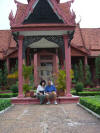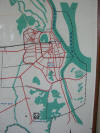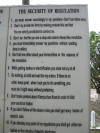
CAMBODIA
NOTE: "HOME" takes you to our
initial home page; "UP" will return you
to the Round The World 2007 site
for more exploring.
6 October: We left the Victoria Hotel (our residence in Chau Doc) via the hotel’s speedboat for a ride up the Mekong River to Cambodia. We stopped first at the Vietnam border to complete our exit documents. We then stopped at the Cambodian border (~1KM away) to obtain our entry documentation. After that, it took about three hours to reach Cambodia’s capital city, Phnom Pehn. At the dock, we were met by our host, Mr. Kosal.
Phnom Pehn is located at the conflux of four rivers: The Upper Mekong, The Lower Mekong, the Tonle Sap and the Tonle Bassac. In the afternoon, we visited Cambodia’s National Museum. There we saw many relics from Cambodia’s past. Photographs are not permitted inside so we only have shots of the exterior and interior garden.
Click on the image to display a larger photo. Once
displayed,
click on the BACK button (first button on the left of your browser)
to return to this page.
 |
The exterior of the National Museum |
 |
A beautiful elephant sculpture in the Museum Garden |
 |
Us enjoying the Museum Garden |
7 October: This morning we visited The Royal Palace (Chatomuk Mongkul). The Palace was constructed twice: first in 1434 before the Royal Family moved to Oudong and then again in 1866 when the Royal Family returned. The grounds and buildings are beautiful! We began at a covered pavilion (Preah Tineang Phochany), a dancing hall where the Royal Ballet Corps perform for the King and his guests. Also, the King uses this area for public addresses. We then saw the Victory Gate which is opened only for the King and other VIPs. We visited the Throne Hall where the royal coronation ceremony occurs. It also is used by the King during various holidays and during visits from national and international dignitaries. We also visited the building used to house the Cambodia Royal regalia (Ho Preah Khan or Samritvimean). We were able to take photographs of the Royal Residence (Preah Moha Prasat Khemarin) and the flag was displayed so the King was at home. One highlight of the tour was seeing the Silver Pagoda or The Temple of the Emerald Buddha. Its floor is completely covered with 5,329 silver tiles, each tile weighing 1.125kg (over 2 lbs.). The Temple is dominated by a Green Buddha (made of Baccarat Glass) and the Future Buddha (Buddha Maitreya) which is a golden statute weighing 90KG and adorned with 2,086 diamonds, the largest on Buddha’s crown weighing 25 Karats. In addition, the temple contains more than 1,650 other artifacts made of precious metals and stones. All were stunning!
Click on the image to display a larger photo. Once
displayed,
click on the BACK button (first button on the left of your browser)
to return to this page.
We had a sober afternoon as we visited The Killing Fields (Choeung Ek) where, between 1975 and 1978, some 17,000 people were killed during the reign of the Khmer Rouge and their leader, Pol Pot. They were bludgeoned to death to avoid “wasting” precious bullets. Over 8,000 skulls are housed in the Memorial Stupa there. We also visited Toul Sleng Museum known as the Genocide Museum. In 1975 Toul Sleng Prey High School was taken over and became a prison known as S-21 (Security Prison 21). It was one of many detention and torture centers located in Cambodia. Individuals detained here were ultimately taken by truck to The Killing Fields if they survived the initial torture handed out by the Khmer Rouge. It’s hard to take any photographs; it’s hard to believe the atrocities which killed over 2 million Cambodians have gone unpunished (however, trials of some of those perpetrators still alive have begun this month).
Click on the image to display a larger photo. Once
displayed,
click on the BACK button (first button on the left of your browser)
to return to this page.
 |
A map defining the area of The Killing Fields |
 |
Rules of the Toul Sleng S-21
Prison (translated into English) |
 |
One of the tiny cells at S-21 Prison |
 |
The Memorial Stupa housing over 8,000 skulls |
8 October: We drove out of Phnom Penh southward to a small town about 14KM from the Vietnam border. There we took a boat for an additional 30 minute ride to a tiny island village. On the island we visited two temples from the 6th century in an area known as Phnom Da which was the first capital of what is now Cambodia. The first, and larger temple, is the Queen’s Temple. It sits on high ground and several caves below it are also turned into places of worship. After hiking to get a close-up view of the temple, we stopped and distributed “goodies” to the island residents. Our host, Mr. Kosal, distributed items we had brought such as pens, paper, razors, shampoo, soap, etc. These people are very isolated and very poor. Afterwards, we visited the second temple, the King’s Temple. This temple reflects much more Indian influence in its design.
Click on the image to display a larger photo. Once
displayed,
click on the BACK button (first button on the left of your browser)
to return to this page.
We left this village and proceeded on via boat to the larger town of Angkor Borei. This was once an ancient settlement. In a few places the town walls still exist but since the town has remained inhabited, no ruins exist. Instead, there is a museum which houses a few of the artifacts found in the area.
Click on the image to display a larger photo. Once
displayed,
click on the BACK button (first button on the left of your browser)
to return to this page.
We finished our day at the Phnom Penh Zoo which is located about 40KM outside of town. Despite it being late in the day, the Zoo was very busy due to a four-day holiday. We were “guided” by two young boys selling sugar cane which can be fed to the many monkeys which roam freely in the zoo. At closing time, we headed back to town and spent our final night out in Phnom Penh at the famous Foreign Correspondent’s Club. It was a wonderful close to our visit to this city.
9 October: Today we were in transit from Phnom Penh to Siam Reap. We took a speed boat for the ride up the Mekong River and through Ton Le Sap Lake. We arrived early afternoon and spent the balance of the day relaxing before heading into the old town for dinner.
10 October: We spent our morning visiting Angkor Thom, an ancient capital (it became the capital after Phnom Da). We entered through the South Gate (used for common people). Our visit then focused on the Bayon, a Buddhist temple, built by King Jayavarman (King VII). Many of the walls are engraved with cartouches which depict all aspects of life at that time. We also visited the Elephant Pavilion and the Crematorium. It was an absolutely fascinating visit!
Click on the image to display a larger photo. Once
displayed,
click on the BACK button (first button on the left of your browser)
to return to this page.
In the afternoon, we visited one of the most intricately carved temples, Banteay Srei. This temple is also known as the Citadel of Women. While not large, it was nevertheless stunning! The details of the carvings were incredible and most were in excellent condition.
Click on the image to display a larger photo. Once
displayed,
click on the BACK button (first button on the left of your browser)
to return to this page.
11 October: We spent our morning at Ta Prohm, one of the temples which have been left unrestored. There are jumbles of rubble rocks where roofs have collapsed and others were carved columns have fallen. Amid the setting are numerous trees which have grown into the temple. They now help hold the stones in place with massive roots. We guess we were the only ones who had no idea that the film Lara Kroft: Tomb Raider (featuring Angeline Jolie) had been filmed there. It was a very, very popular stop for tourist photos. We really enjoyed Ta Prohm because it provided a glimpse into how the temples in the area looked when initially discovered.
Click on the image to display a larger photo. Once
displayed,
click on the BACK button (first button on the left of your browser)
to return to this page.
Our afternoon was spent visiting the wonderful Angor Wat. It is so stunning and beautiful that it’s difficult to find words to describe it. The complex was built in the 1100’s and its main spires are taller than Notre Dame. The overall complex encompasses some 40 acres and it was supported by a community of 20,000+ individuals. Residing in the complex were the Royal Family and their support staff (including 615 Apsara dancers), religious leaders and military personnel. We fell in love with the setting and spent quite a bit of time just viewing our surroundings from one building or another. We also walked the length of the building which contains a bar relief of life at the time, including much history of battles. Again, fascinating! Our visit here was the perfect way to end our time in Cambodia.
Click on the image to display a larger photo. Once
displayed,
click on the BACK button (first button on the left of your browser)
to return to this page.
12 October: This was a day of travel from Siam Reap to Bangkok, Thailand. Since we previously visited Thailand, we spent only one night at the Airport Hotel before proceeding the next day to Singapore.
or